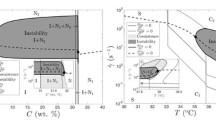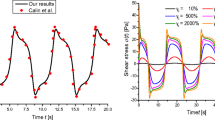Abstract
The non-monotonic shear flow of a viscoelastic equimolar aqueous surfactant solution (cetylpyridinium chloride-sodium salicylate) is investigated rheologically and optically in a transparent strain-controlled Taylor Couette flow cell. As reported before, this particular wormlike micellar solution exhibits first a shear thinning and then a pronounced shear-thickening behavior. Once this shear-thickening regime is reached, a transient phase separation/shear banding of the solution into turbid and clear ring-like patterns orientated perpendicular to the vorticity axis, i.e., stacked like pancakes, is observed (Wheeler et al. 1998; Fischer 2000). The solution exhibit several unique features as no induction period of the shear induced phase, no structural build-up at the inner rotating cylinder, jumping pancake structure of clear and turbid ringlike phases, and oscillating shear stresses appear once the pancake structure is present. According to our analysis this flow phenomenon is not purely a mechanical or rheological driven hydrodynamic instability but one has to take into account structural changes of the oriented micellar aggregates (flow induced non-equilibrium phase transition) as proposed by several authors. Although this particular flow behavior and the underlying mixture of shear induced phases and mechanical instabilities is not fully understood yet, some classification characteristics based on a recent theoretical approach by Schmitt et al. (1995) and Porte et al. (1997) where a strong coupling between the flow instability (non-homogeneous flow profile due to the bands) and the structural changes causes the observed transient phenomena can be derived. In reference to the presented model the observed orientation of the rings is typical for complex fluids that undergo a spinodal phase separation coupled with a thermodynamic flow instability. In contrast to other shear banding phenomena, this one is observed in parallel plate, cone-plate, and Couette flow cell as well as under controlled stress and controlled rate conditions. Therefore, it adds an additional aspect to the present discussion on shear banding phenomena, i.e., the coupling of hydrodynamics and phase transition of rheological complex fluids.
Similar content being viewed by others
Author information
Authors and Affiliations
Additional information
Received: 8 January 2001 Accepted: 15 May 2001
Rights and permissions
About this article
Cite this article
Fischer, P., Wheeler, E. & Fuller, G. Shear-banding structure orientated in the vorticity direction observed for equimolar micellar solution. Rheol. Acta 41, 35–44 (2002). https://doi.org/10.1007/s003970200003
Issue Date:
DOI: https://doi.org/10.1007/s003970200003




